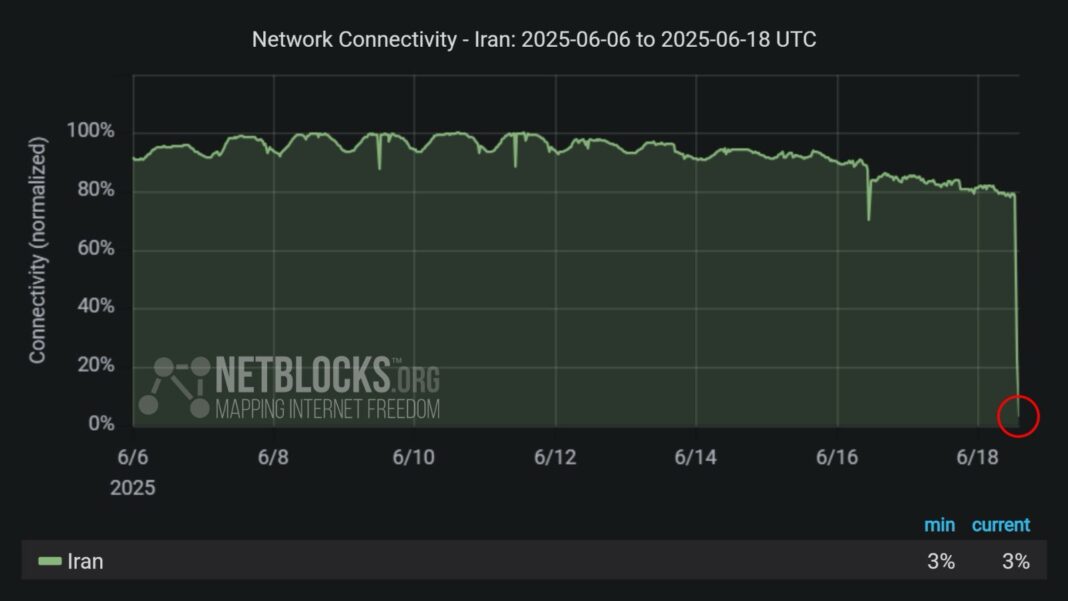• Iran reportedly shut down the internet after six days of intense fighting with Israel.
• Digital watchdog NetBlocks confirms the blackout amid missile strikes.
• Amnesty’s 2019 investigation reveals a pattern: shut down the internet, commit abuses.
• In 2019, over 323 Iranians were killed during protests as the internet went dark.
• Human rights experts fear another cover-up is unfolding.
After nearly a week of fierce conflict with Israel, Iranian authorities have taken a dramatic step: a near-total national internet blackout. This sudden digital silence, confirmed by independent watchdog NetBlocks, is raising deep concerns among human rights groups and observers around the globe.
⚠️ Confirmed: Live network data show #Iran is now in the midst of a near-total national internet blackout; the incident follows a series of earlier partial disruptions and comes amid escalating military tensions with Israel after days of back-and-forth missile strikes 📉 pic.twitter.com/Iu598aIMRJ
— NetBlocks (@netblocks) June 18, 2025
What Could Be the Strategy Behind the Shutdown?
Amid wartime, one might expect governments to boost communication. But in Iran, internet shutdowns are often a tool of oppression and obfuscation. The blackout likely aims to:
- Suppress domestic dissent during wartime hardship
- Obstruct citizens from sharing video evidence of abuses
- Prevent international monitoring of military or civil responses
The 2019 Shutdown: A Precedent of Violence and Silence
This isn’t the first time Iran has silenced its population through digital darkness. A joint investigation by Amnesty International, The Hertie School, and the Internet Outage Detection and Analysis (IODA) project found that during November 2019, Iranian authorities cut off most internet services as they unleashed a violent crackdown on mass protests triggered by a sudden rise in fuel prices.
Security forces killed at least 323 men, women, and children during five days of unrest. Most were shot in the head or torso—clearly aiming to kill. To this day, no one has been held accountable for the bloodshed.
Part 1: Into the Dark
Protests erupted on 15 November 2019, after a fuel price hike announcement overnight. Demonstrators, many from working-class communities, called for an end to the Islamic Republic and constitutional reform. Videos of the protests and security force brutality quickly flooded social media.
By the afternoon of 16 November, Iran’s internet was collapsing. Cellular services dropped around 2 pm; by 7 pm, the country was largely offline—except for domestic services. This blackout allowed government operations to continue while silencing public voices.
On state TV, Interior Minister Abdolreza Rahmani Fazli said, “We will restore calm,” a signal that lethal repression would follow. That day became the bloodiest of the uprising—with over 100 civilians killed, including children.
Lethal Force and International Law
International law allows lethal force only when strictly unavoidable to prevent imminent death or serious injury. Iran’s use of deadly force against largely peaceful protesters constituted arbitrary killings and, potentially, extrajudicial executions.
Part 2: Uncovering the Killings
Amnesty eventually verified 323 killings, though the true toll is likely higher. Of these, 237 occurred within 48 hours of the blackout. Investigators verified victims through medical documents, family interviews, death certificates, and visual evidence. Nearly half were identified with details such as injury location and cause of death.
Witnesses told Amnesty they deleted videos from their phones, fearing arrest or torture. The blackout thus destroyed not only live communication, but also crucial evidence of government crimes.
Not Just Iran: A Global Trend of Repression
According to the UN Human Rights Committee, states must not block or hinder internet access during peaceful assemblies. Yet, countries like Myanmar, Sudan, Belarus, Ethiopia, and Venezuela have done just that. In every case, the goal is similar: information control, repression, and immunity from scrutiny.
What Is an Internet Shutdown?
An internet shutdown is when a government or authority intentionally disrupts access to the internet or communications, rendering them inaccessible. This can occur regionally or nationwide. In Iran, while the global internet was blocked, the domestic network remained live for banking and government continuity—ensuring internal functionality while silencing external reach.
Conclusion: What This Means Now
The blackout in June 2025 echoes a haunting history. If the past is any indicator, it signals more than disruption—it could precede another wave of violence hidden behind a digital wall. As the conflict with Israel intensifies, the international community must remain vigilant, and watchdogs must document every byte that disappears into the void.
📚 Read More from Virginia Times
- Iran’s Supreme Leader Warns U.S. and Israel of “Irreparable Consequences”
- Trump Demands “Unconditional Surrender” from Iran
- Israel-Iran Conflict Timeline: What You Need to Know
(with inputs from Amnesty International, NetBlocks, IODA, The Hertie School, and public statements)
A global media for the latest news, entertainment, music fashion, and more.















